How much product do you put on the pad? Do you prime it?
by Ivan RajicThis is a question that a lot of readers and other detailing enthusiasts new to machine polishing ask quite a bit. Having the correct amount of polish on the pad is very important because it ensures you get the results you’re after without using too much or wasting time on non-necessary polishing. Due to the many pad and polish combinations out there, all the different machines, as well as different goals from a polishing job, it’s really all but impossible to give the “right” answer for every scenario.
That said, my focus here is to give a sort of general guide on applying polish to pads. I almost exclusively use the Flex XC 3401 VRG polisher with 5.5″ Lake Country Pads. One important factor to consider is whether you’re using a polish with diminishing or non-diminishing abrasives. As you’ll see below, I prefer to use a lot less polish on the pad when using diminishing abrasives because those polishes typically have longer work times and you’re better off using a proper amount per section of paint.
First off, here’s a few photos to explain my process when using Meguiar’s D300 Correction Compound with a 5.5″ Lake Country Orange Pad. The following process is also used with other polishes utilizing non-diminishing abrasives, such as Meguiar’s Ultra-Cut Compound M105 and Meguiar’s Ultra Finishing Polish M205. I like to first prime the pad well over the entire surface area.
I do this by pouring out some polish in a circular pattern over the entire pad…
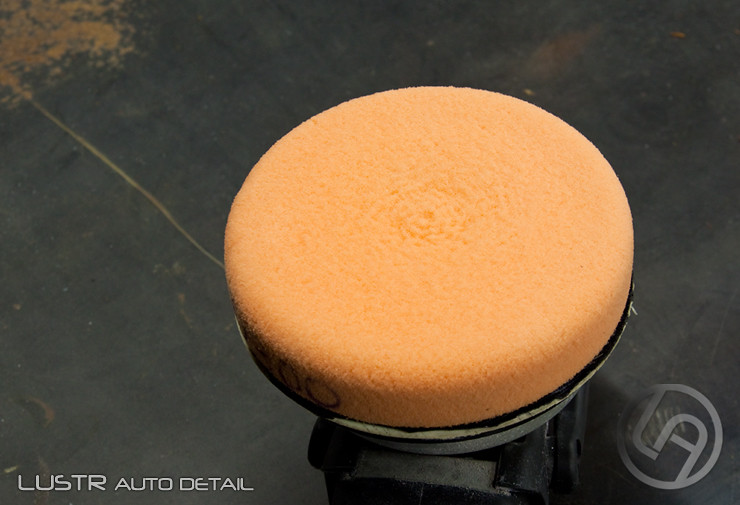

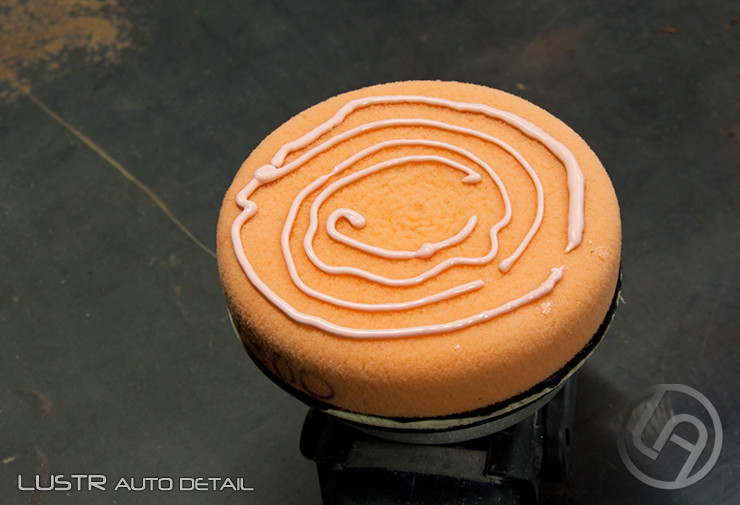
Then I spread that polish out with my finger to completely prime the pad…
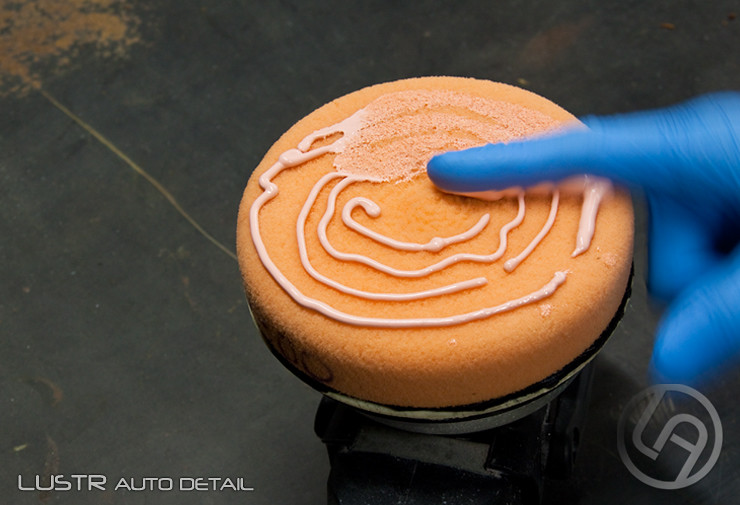
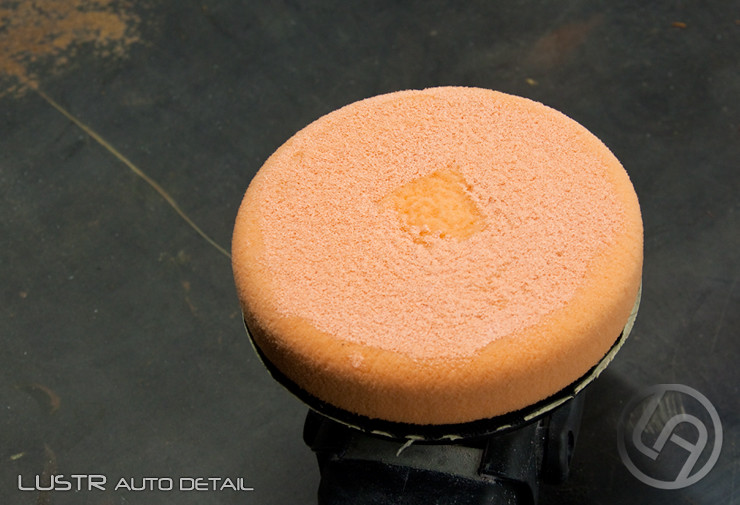
Once that’s done, I’ll apply small amounts of polish to certain areas I may have missed the first time around…

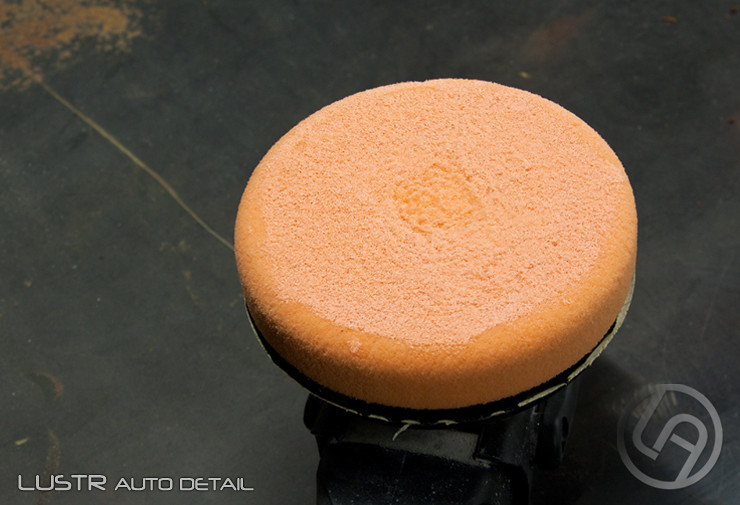
Now my pad is ready to polish a section of the paint. Once I’m done polishing that section and using a brush over the pad to get rid of dust and residue (for more info on cleaning pads please refer to my article Pad Cleaning During and After Polishing), I apply some more polish to do the next section. Following the first priming of the pad, I typically apply the following amount or less…
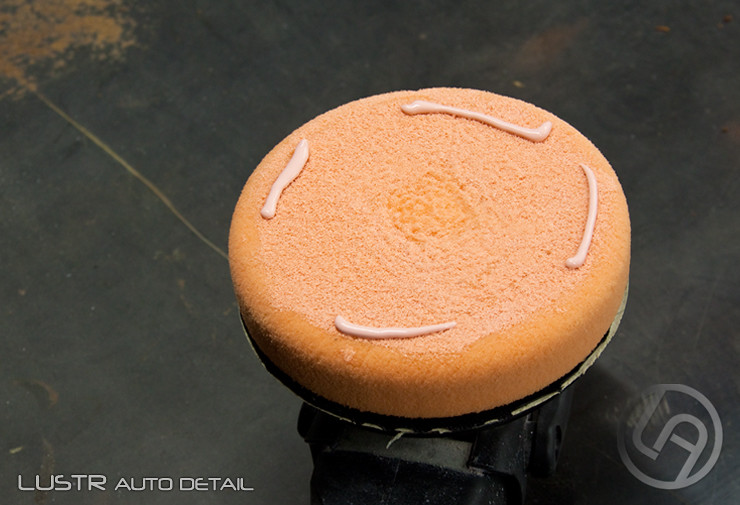
As much as it’s important to apply proper amounts of polish to the pad during a polishing job, it’s just as important to know when to call it quits with one pad and start with a fresh one. I also go over that in more detail in my above mentioned article, but in short, pads get saturated with polish and paint residue, so after a certain point they don’t work nearly as well as they should. Thus, it’s necessary to replace them as often as the job calls for it.
For diminishing abrasive polishes, such as Menzerna Micro Polish SF 4500 (PO85RD), it’s necessary to use a lot less polish and no priming is required. For these polishes, I use the following amount of polish…



I use this much polish on the pad whether it’s the first polish application to a fresh pad or second, third, etc. Regardless of the type of polish though, the pad will get too saturated over a few sections, so it will require replacement with a new, clean pad.
That said, I do encourage others to use this as only a general guide, while experimenting with both more and less polish. It has happened plenty of times where a helper of mine, with only 2-3 months polishing experience vs my 5-6 years’ worth, finds a better polish amount to use and/or technique with the machine that results in slightly better results.
I hope this is a helpful guide for many readers out there and thanks to all for reading!










Ivan –
Great post! Thank you very much!
It was nice you gave your ‘helper’ that slight bit of credit.
Curiously, how does one identify a diminishing abrasive vs not? Are Menzerna polishes generally considered diminishing abrasives? Are Meguiars generally non-diminshing?
Regards,
Great write up! One question, how do you know if the product you’re using uses diminishing or non-diminishing abrasives?
Thanks Jon and Diego.
The easy answer to your question is to simply ask the manufacturer what product is diminishing and which is not. Otherwise, it’s hard to tell unless you have extensive experience with all different types of polishes, and even if you do you’d need to do quite a bit of testing with any given polish to check which kind it is.
Generally, most polishes available are diminishing abrasives, but there’s not really a specific manufacturer, like Meguiar’s, producing one or the other. Meguiar’s, for example, has both types of polishes, so as I said above, best is to simply ask the manufacturer on the type of polish and their recommendation on how to use it.
Hope that helps!
I appreciate the tip – thank you.
Thanks for your help. Do you think a review of the FLEX 3401 is in the near future? I use one and i think a review would show people how great of a machine it is .
I use one and i think a review would show people how great of a machine it is .
Funny you mention it since I’m actually working on it right now. Should be done sometime this month, so keep an eye out for it in the near future.
This might be a bit much, but would you consider posting a YouTube video of your Flex 3401 implementation?
Jon,
What exactly did you want to see in a video? A video is definitely not out of the question so I will surely consider it if I’m able to use a good camera at the time, but I’d like to know exactly what you’d like to get out of such a video.
Thanks!
Great posts Ivan! and in regards to the video question, I think it’s always nice to see how much product you put on the pad, the length and width of the area being polished, how much pressure applied, arm speed, patterns, and of course, before/after.
I know you covered some of these in past posts, but to incorporate it all into a single video would make a very helpful polishing tutorial, even for a Porter Cable.
Makes perfect sense Jack. I’m in the process of learning or trying to learn how to record better quality videos, so that will definitely be on the to do list. Thanks
Hi Ivan,
thank you for the post, it’s most informative. I just have a bit of question about the diminishing abrasive.
I started to try and detail my own car recently, and just got a rotary (I practice with my mom’s car – a beater). I found that when I use the Menz SF 4500, it seems that three beads is not enough. When I tried it, the pad kind of squeaks, and I’m a little worried that it’ll do something bad (I tried touching the paint surface, and it’s quite hot).
I use a Hitachi, and start at 600 RPMs, but the squeaks start when I try to raise the speed (around 900 RPMs). I found that if I primed the pad first, just like the non-diminishing abrasive sample you gave, it doesn’t squeak. The result is kind of good – the car’s metallic gray, so maybe I don’t see the swirls quite well though.
Am I doing something wrong? For your info, I live in Indonesia, where the temperature is quite high. I don’t have a proper garage, just a carport.
Thanks in advance!
Hi Ernesto,
Happy to see some international readers!
To answer your question:
Since you’re new to a rotary polisher, you have quite a ways to go before figuring out all the little tips and tricks. First of all, I would highly recommend a different polish for a first time rotary user. Menz SF 4500 is a polish that does take a bit of skill and experience to use, because you can easily apply too much or too little and wrestle with the polisher for hours. That said, I would suggest maybe a lighter Meguiar’s polish, something like Meguiar’s Speed Glaze M80. It’s hard to explain how the SF 4500 is harder to use than the M80 until you experiment with both of them with the same machine and pad and at the same speeds. SF 4500 can cause the rotary polisher to pull you around quite easily if you apply too much or too little, whereas the M80 is a bit more user friendly. Hope that makes sense.
Also, another good idea for a novice rotary operator is to apply just a bit more polish than necessary in order to have more time to work with it and make it easier to learn the machine.
As for if you’re doing something wrong… well, to be frank you may as well be. You may be moving way too slow so the polish gets “used up” quicker than it would at normal arm speeds, all of which would result in paint getting quite hot. At the same time, you may simply be working in very hot temperatures where any polishing will heat up the paint fairly quickly.
I will be working on a rotary polishing tutorial in the near future for the blog, but in the meantime I would suggest simply viewing some of the other articles here regarding rotary polishing as well as watching some YouTube videos from trusted sources.
Hope that helps a bit Ernesto!
Hi Ivan,
thank you so much for the quick reply! I didn’t know that the SF 4500 needs a bit more experience in using – I got it after reading the reviews (including one here at Detailed Image), especially the part where it’s friendly on soft paint.
My car’s a 2010 Honda with metallic black paint. I tend to think that the paint can get swirls just by looking at it. I used the two bucket method with grit guards to wash it, dried it carefully (or at least I think I did), and yet still got swirls. I want it to look nice, and that’s what made me pick the SF 4500. But if it’s easier, I’ll give the M80 a shot and see how it goes.
So far, my knowledge for detailing comes mostly from the web, and also from trial and error. Luckily, I got my mom’s car to practice on.
I really look forward to your rotary tutorial, and again, thank you very much for the great info!
Ivan – Great briefing on pad priming!
Few questions if you don’t mind.
1. What is a standard practice for using “ALL” Menzerna compounds or polishes on pads? Should pads be primed using the “KBM” or not for Menzerna products. There can be some confusion on when to prime or NOT to prime with diminishing or non-diminishing products. Or is this really personal preference?
2. Should one “mist” the pad if no priming is done prior to applying three pea sized product on the pad?
Thanks for your assistance.
Hi Todd,
Thanks for the great comments. To answer your questions…
1. From my experience, priming pads with Menzerna polishes really shouldn’t be done, especially with the finer polishes, because most have pretty long work times. This means that if you prime the pad, you’re looking at not only polishing the section for much longer than necessary, but also risk gumming up the pad too quickly, which can results in poor polishing results as well as make the machine very hard to control. I typically prime pads only when doing correction work and only when working with Meguiar’s polishes like M105, D300 and M205. If I’m using M205 as a finishing polish I usually won’t prime it but will put on a bit extra polish on the initial pass. Long story short, I think it can be greatly influenced by personal preference and experience, so I would recommend trying it both ways and seeing what works better for you.
2. I was never a fan of misting pads but many have had great results, so it may be another thing to try and see for yourself.
I apologize for the indecisive answers, but the topics in question are definitely quite subjective so I can only tell you my preference.
Hope that helps bud, thanks!
Hey Ivan,
I’m familiar with using the PC 7424XP with Meg’s M105/M205. However, I’m going to tackle my brother’s black car this weekend and bought some SF 4500 polish. I’m glad I came across this article because I was ready to prime the heck out of my pad with the SF 4500. I would have been polishing for hours. =/
I had a weird thought. Why do we need to use less of diminishing abrasive polishes? It sounds counter-intuitive to use less of something that naturally breaks down. Shouldn’t it be the other way around?
Regards,
Tom
Hi Tom,
Typically, the diminishing abrasives take time to break down from larger to smaller, which is why the work time is quite long (at least compared to non-diminishing abrasives). During this time, the polish needs its own “lube” in order to not marr up the paint with the larger abrasives and also to allow easier application, especially via a rotary polisher.
So in other words, yes I agree how it may sound counter-intuitive at first, but as you can see, polishes with diminishing abrasives need time to break down and refine the finish, so the more of it you use the longer you need to work at breaking it down. This now becomes counter-intuitive, at least in terms of efficiency, so you must use less.
You can even do a test on a black car with the SF 4500 polish if you get a chance. Simply put some on the pad (3-4 dime sized drops) and polish a small section by doing only 3 passes (1 to spread it at a slow speed (2-3), and 2 passes at speed 5 or 6. Then, do the same exact thing on a section next to it but do 5-6 passes and compare the finish. If the paint is a typical,soft black paint, you should notice how much better the finish is after 5-6 passes as compared to only 2-3.
On the other hand, the non-diminishing abrasives kind of follow the rule “it is what it is”. So generally you can do 2 or 6 passes and leave the finish looking just about the same. With the non-dim abrasives you can use pressure and pad abrasiveness to your advantage and be able to get different results with the same polish/pad/speed combo. For both kinds of polishes though, you don’t want to polish for too long as you might end up “dry polishing” and definitely marr the paint.
Hope that helps!
Please let me know if you’re looking for a article author for your blog. You have some really good articles and I believe I would be a good asset. If you ever want to take some of the load off, I’d love to write some material for your blog in exchange for a link back to mine. Please send me an e-mail if interested. Thank you!
My blog post: no no hair smart
What I really like about all of you guys is how detailed and thorough you are with your presentations, leaving nothing to chance or misunderstanding. Even down to the excellent photography which illustrates your points “down to the T.” On top of all that, you are some really nice guys who encourage novices and show a passion for your vocation. Thanks for the good advice and help you give, and keep up the good work.
New here. Have you done the tutorial or video on the Flex 3401 yet?
Thanks
I have yet to do this but will try to find time asap. I am currently booked with detail work until well into June, so time for thorough video tutorials is very tight as you can imagine. I’ll be posting it up here as soon as I get it done.
It waas funny.
e-mail subscription hyperlink or newsletter service.
I like to write a little comment to